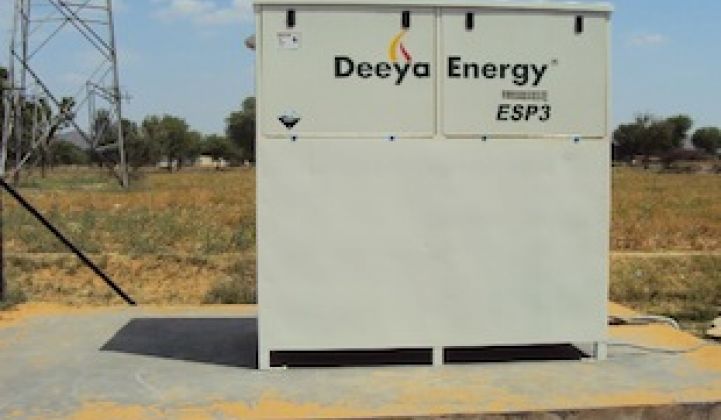For the last few years, Deeya Energy has made flow batteries for backup power at telecom towers in India, a small corner of the energy storage business.
Now the company, renamed Imergy Power Systems, has a new battery chemistry and a new management team to help it take on a much wider market.
Imergy Power Systems announced last week that Bill Watkins, who headed disk drive maker Seagate and LED company Bridgelux, is now CEO. He has brought on board two other seasoned executives -- Tim Hennessy, who was previously president of flow battery maker Prudent Energy, and Jack Jenkins-Stark, the former CFO of solar developer BrightSource Energy.
Imergy Power also announced a design deal with contract manufacturer Flextronics to bring the new generation of its products to market more quickly.
Venture investors Technology Partners and NEA lured the executives over with a promising new flow battery chemistry developed by Imergy’s chief technology officer, Majid Keshavarz. Deeya Energy’s first battery used an iron-chrome chemistry, but Keshavarz designed a vanadium-based system that executives say can deliver long life and lower costs.
“I got convinced this chemistry is the real deal,” said Watkins, who had bought land after leaving Bridgelux and considered becoming a farmer.
Flow batteries are well suited for grid energy storage because they are less expensive than lithium-ion batteries, they last for several years, and they can provide power for multiple hours. A flow battery has two tanks of liquid electrolytes that circulate through a chamber where a chemical reaction occurs across a membrane. Building larger tanks will expand the battery’s storage capacity, which is independent of its power rating.
The challenge, as with all types of bulk grid storage, is getting the cost below that of the alternatives, which in many cases could be a natural gas peaking plant. The vanadium chemistry will enable Imergy Power, an eight-year-old company with operations in India, to get production costs below $300 per kilowatt by 2015, company executives said. That’s less than half the cost of today’s flow batteries, said Hennessy.
The company’s latest design adds a low-cost catalyst to the electrolytes that improves the energy density, helps control gas buildup and allows the batteries to operate at high temperatures. That means active cooling systems aren’t necessary, Hennessy said.
“This stuff works. I’ve proven it at megawatt scale, but now this addresses three issues with flow batteries,” he said.
Through its partnership with Flextronics, Imergy Power plans to introduce a 5-kilowatt/30-kilowatt-hour battery for telecom towers or residential applications. Through internal development, Imergy Power will develop a 250-kilowatt system, slated for introduction next fall. This larger battery will be designed for use to buffer microgrids in countries where there is no centralized grid and power is provided by diesel engines. The company also intends to sell batteries for behind-the-meter applications to shave peak power and to firm up the output of solar and wind farms.
There is a lot of competition in grid energy storage. Companies are either making flow batteries, lithium-ion batteries, compressed air storage machines, or are developing batteries with new chemistries. One of the challenges with vanadium is the cost of the material itself. Watkins said the technical improvements are significant enough that they will allow the company to quickly enter new market segments for energy storage.
“At the end of the day, it’s all about hitting cost points and whether you have a technology platform that allows you to scale,” said Watkins. “We can take the chemistry and technology within the flow battery and extend it. That’s what got me off the farm.”



